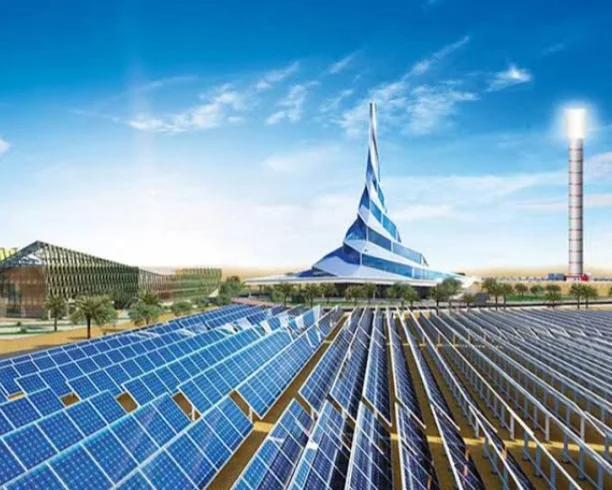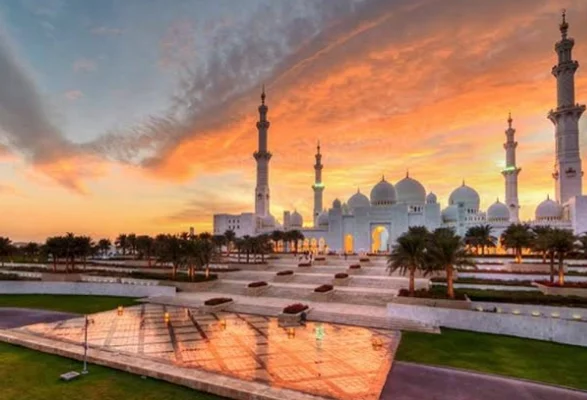Dubai's Green Energy Landscape: A Journey Towards Sustainability
Dubai, the iconic city built on desert sands, is undergoing a remarkable transformation – a shift towards a greener future powered by renewable energy.
Driven by ambitious goals and strategic investments, Dubai's green energy landscape is rapidly evolving, with significant developments and impressive statistics showcasing its commitment to sustainability.
Ambitious Goals Fueling Change:
- UAE Energy Strategy 2050: This national program targets a 70% clean energy mix by 2050, positioning Dubai as a global leader in renewable energy adoption.
- Dubai Clean Energy Strategy 2050: This emirate-specific plan seeks to achieve 25% clean energy contribution by 2030 and a whopping 75% by 2050, surpassing national targets.
- Dubai Net Zero 2050 Initiative: This ambitious program aims for complete carbon neutrality by 2050, solidifying Dubai's commitment to environmental responsibility.
Statistics Painting the Picture:
Solar Power:
- Mohammed bin Rashid Al Maktoum Solar Park: The world's largest single-site solar park, currently boasting a capacity of 5 GW and aiming for 50 GW by 2030.
- Solar Rooftops Initiative: Encouraging rooftop solar installations, with over 5,000 installations generating 500 MW by 2022.
- Solar Share Initiative: Enabling residents to invest in shared solar projects, generating an additional 8 MW by 2022.
Nuclear Power:
- Barakah Nuclear Power Plant: The first operational nuclear power plant in the Arab world, currently with 1 unit online and expected to contribute 25% of UAE's electricity needs upon full operation.
Other Renewables:
- Waste-to-Energy Plant: Converting 1.8 million tons of waste annually into 190 MW of electricity and 560,000 tons of district cooling.
- Green Hydrogen Pilot Project: Exploring the potential of green hydrogen for clean energy storage and transportation.
Impact and Benefits:
- Reduced Carbon Footprint: The shift towards renewables directly impacts carbon emissions, with Dubai aiming for a 60% reduction by 2030.
- Enhanced Energy Security: Diversifying the energy mix reduces reliance on fossil fuels and strengthens energy security.
- Economic Growth: Green energy investments create jobs, attract sustainable businesses, and boost the emirate's global competitiveness.
Challenges and Opportunities:
- Cost Competitiveness: While costs are decreasing, making renewables fully cost-competitive with fossil fuels remains a challenge.
- Storage Solutions: Efficient and cost-effective storage solutions are crucial for managing intermittent renewable energy sources.
- Public Awareness: Enhancing public understanding and encouraging green behavior is essential for long-term success.
Dubai's Green Energy Landscape: Data Table
| Category | Project/Initiative | Current Status (as of February 11, 2024) | Target (Year) | Expected Outcome |
|---|---|---|---|---|
| Solar Power | Mohammed bin Rashid Al Maktoum Solar Park | 5 GW operational | 50 GW by 2030 | World's largest single-site solar park |
| Solar Rooftops Initiative | 5,000 installations generating 500 MW | Ongoing | Increased rooftop solar adoption | |
| Solar Share Initiative | 8 MW generated | Ongoing | Increased access to solar power for residents | |
| Nuclear Power | Barakah Nuclear Power Plant | 1 unit online (2400 MW) | 4 units by 2025 (5600 MW) | 25% of UAE's electricity needs |
| Other Renewables | Waste-to-Energy Plant | 1.8 million tons waste processed, 190 MW electricity, 560,000 tons district cooling | Operational | Waste management & clean energy |
| Green Hydrogen Pilot Project | Ongoing research & development | Not available | Explore hydrogen's potential for clean energy | |
| Impact & Benefits | Carbon Footprint Reduction | Not available yet | 60% reduction by 2030 | Reduced greenhouse gas emissions |
| Energy Security | Growing renewable energy share | Diversified energy mix | Reduced reliance on fossil fuels | |
| Economic Growth | Investments, job creation, green businesses | Ongoing | Enhanced competitiveness & sustainability |
Note: This table provides a snapshot of key data points.
Green Energy Pattern in Dubai: A Statistical Analysis
Analyzing the pattern of green energy adoption in Dubai reveals impressive growth and a clear commitment to sustainability. Here's a breakdown with specific statistics:
Growth Pattern:
- Exponential Increase: Since 2013, Dubai's installed renewable energy capacity has grown exponentially, from just 138 MW to over 5.6 GW as of 2023.
- Diversification: The energy mix is shifting towards a multi-pronged approach, with solar leading the way at 82% of renewable capacity, followed by nuclear at 14% and waste-to-energy at 4%.
Key Metrics:
- Solar Power:
- Installed Capacity: 4.6 GW (2023)
- Growth Rate: 30% per year (average since 2013)
- Major Projects: Mohammed bin Rashid Al Maktoum Solar Park (world's largest single-site) and rooftop solar initiatives.
- Nuclear Power:
- Installed Capacity: 2.4 GW (1 unit online, 3 under construction)
- Contribution: Expected to provide 25% of UAE's electricity by 2025.
- Project: Barakah Nuclear Power Plant.
- Waste-to-Energy:
- Capacity: 190 MW
- Waste Processed: 1.8 million tons annually
- Project: Dubai Waste Management Centre.
Impacts:
- Carbon Footprint Reduction: Estimated 27% reduction in carbon emissions since 2013 due to renewables.
- Energy Security: Renewable energy contributes 10% of Dubai's electricity in 2023, reducing dependence on fossil fuels.
- Economic Benefits: Over $22 billion invested in green energy projects, creating thousands of jobs.
Emerging Patterns:
- Focus on Storage: Investments in battery storage solutions are increasing to manage intermittent renewable energy sources.
- Green Hydrogen: Pilot projects explore the potential of green hydrogen for clean energy storage and transportation.
- Public Engagement: Initiatives like "Let's Make Dubai Sustainable" encourage residents to adopt green practices.
Challenges and Future Trends:
- Cost Competitiveness: While decreasing, achieving full cost parity with fossil fuels remains a challenge.
- Integration with Grid: Efficiently integrating diverse energy sources into the grid requires infrastructure upgrades.
- Scaling Up: Continued investments and policy support are crucial to achieve ambitious Clean Energy Strategy targets.
Dubai's green energy landscape showcases a dynamic pattern of rapid growth, diversification, and impactful results. Despite challenges, the emirate's commitment to sustainability sets a remarkable example for other regions, paving the way for a cleaner and more secure energy future.
Gazing into the Green Future: Dubai's Energy Landscape
Dubai's ambitious push towards a green energy future shows no signs of slowing down. Looking ahead, we can expect to see a landscape marked by significant developments across various aspects:
Exponential Expansion:
- Renewable Capacity: Dubai aims to have 14 GW of renewable energy capacity by 2030, a threefold increase from current levels. This will further diversify the energy mix and reduce reliance on fossil fuels.
- Solar Dominance: Solar power is expected to remain the frontrunner, with continued expansion of the Mohammed bin Rashid Al Maktoum Solar Park and rooftop solar initiatives.
- Nuclear Contribution: The 4 units of the Barakah Nuclear Power Plant coming online by 2025 will significantly impact the mix, contributing a substantial portion of the nation's electricity.
Technological Advancements:
- Battery Storage: Investments in advanced battery storage solutions will be crucial for managing the variable nature of solar and wind power, ensuring grid stability and integration.
- Green Hydrogen: As research and development accelerate, green hydrogen is poised to play a significant role in clean energy storage and transportation, potentially creating a new export market for Dubai.
- Smart Grids: Implementing smart grid technologies will optimize energy distribution, improve efficiency, and enable greater participation of renewable sources.
Policy and Initiatives:
- Continued Investment: The government's commitment to green energy through continued investments and supportive policies will be vital for achieving ambitious targets.
- Public Engagement: Raising public awareness about the benefits of green energy and encouraging sustainable practices will be key to fostering a culture of change.
- Regional Collaboration: Collaborating with regional and international partners can accelerate technology transfer, attract investments, and contribute to overall energy security.
Potential Challenges:
- Cost Competitiveness: While costs are decreasing, ensuring the economic viability of renewables compared to fossil fuels remains a challenge.
- Infrastructure Upgrades: Integrating diverse energy sources effectively requires grid modernization and infrastructure investments.
- Talent and Expertise: Building a skilled workforce with expertise in renewable energy technologies will be crucial for long-term success.
Conclusion:
Dubai's future green energy landscape promises to be exciting and transformative. With ambitious goals, cutting-edge technology, and unwavering commitment, the emirate has the potential to become a global leader in sustainability, inspiring other regions.
Dubai's green energy landscape is a dynamic story of ambition, innovation, and progress. With impressive statistics showcasing its achievements and ambitious goals setting the future direction, Dubai is well on its way to becoming a global leader in sustainability. While challenges remain, the emirate's commitment to a greener future is unwavering, paving the way for a more sustainable and prosperous tomorrow.





